| Original Article | |
| Antibiotic Resistance Pattern and Risk Factors Associated With Urinary Tract Infections With Pseudomonas aeruginosa Among Women in North West of Iran | |
| Samaneh Rouhi1,2, Rashid Ramazanzadeh2,3 | |
| 1Student Research Committee, Kurdistan University of Medical Sciences, Sanandaj, Iran 2Cellular and Molecular Research Center, Research Institute for Health Development, Kurdistan University of Medical Sciences, Sanandaj, Iran 3Microbiology Department, Kurdistan University of Medical Sciences, Sanandaj, Iran |
|
|
CJMB 2019; 6: 498–504 Viewed : 5518 times Downloaded : 2549 times. Keywords : Antibiotic Resistance Pattern, Risk Factors, Urinary Tract Infections, Pseudomonas aeruginosa, Women |
|
| Full Text(PDF) | Related Articles | |
| Abstract | |
Objectives: Urinary tract infections (UTIs) are related to female anatomy, sexual activity, and menopause. The present study aimed to survey the antibiotic resistance pattern and some risk factors that are associated with UTIs with Pseudomonas aeruginosa. Materials and Methods: In this case-control study, 26 and 21 women patients with and without P. aeruginosa UTIs in case and control groups were considered, respectively, in North West of Iran from December 2015 to August 2017. P. aeruginosa was detected in urine samples using phonotypic test and polymerase chain reaction (PCR). Then, several risk factors were highlighted, including diabetes, kidney failure, pregnancy, residence, hospitalized, ICU stay, ventilator support, nosocomial infection, antibiotic use in the past 14 days, and age. Finally, the disk diffusion method was used to investigate the antimicrobial resistance pattern, followed by analyzing the data by Fisher’s exact test and SPSS 16 (95% CI, P≤0.05). Results: Based on the results, 26 P. aeruginosa strains were detected in both phenotypic test and PCR. In addition, a significant relationship was observed between diabetes, hospitalization, pregnancy, kidney failure, residence, and nosocomial infections with UTIs (P≤0.005). The highest and lowest rate of antibiotic resistance belonged to cefpodoxime and trimethoprim/sulfamethoxazole (each one with 92.30%) and imipenem (19.23%). Conclusions: Overall, UTIs and antibiotic resistance related to P. aeruginosa was observed among women and diabetes and hospitalization were detected as the potential risk factors. Considering the geographic location of Kurdistan province, evaluating the risk factors and periodic reports on antibiotic resistance for UTIs can be more effective in its control and treatment in this area. |
Cite By, Google Scholar
Online Submission System
 CJMB ENDNOTE ® Style
CJMB ENDNOTE ® Style
 Tutorials
Tutorials
 Publication Charge
Medical and Biological Research Center
About Journal
Publication Charge
Medical and Biological Research Center
About Journal
Aras Part Medical International Press Editor-in-Chief
Arash Khaki
Deputy Editor
Zafer Akan


















